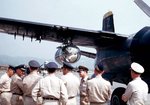I saw an image of an A-26 with internal wing guns and was a bit surprised to see they were outboard of the props. How far apart are these guns. It is my guess there was not room at the wing root to clear the props or perhaps that part of the wing was carrying fuel?
Were the wing guns this far apart practical?
I suppose in strafing infantry the nose gun would be hitting the center with two that may or may not be converged at the right distance and if not I guess it can chew up a lot of turf but still the spacing seemed huge.
Were the wing guns this far apart practical?
I suppose in strafing infantry the nose gun would be hitting the center with two that may or may not be converged at the right distance and if not I guess it can chew up a lot of turf but still the spacing seemed huge.

